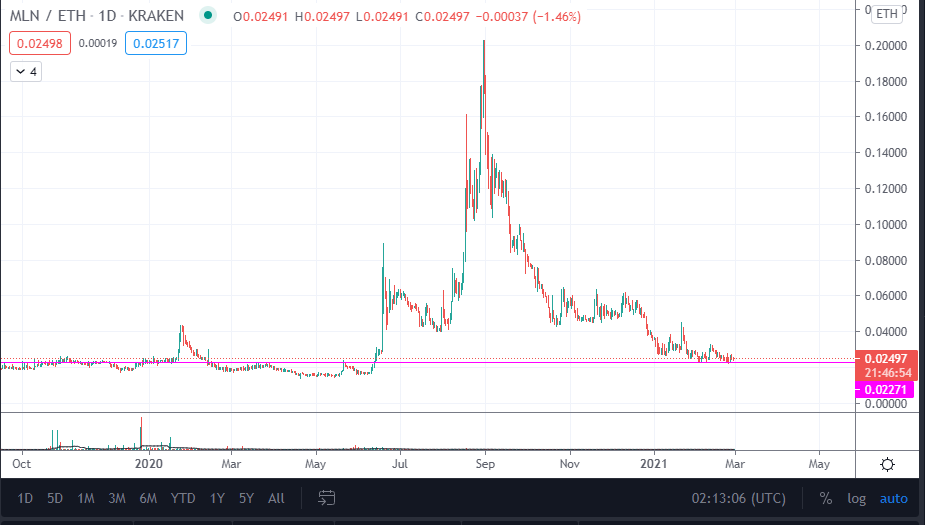Enzyme Finance (FKA Melon)
2/28/21
$MLN
Price: $35.62 (USD)/ 0.0264 (ETH)
Market Cap: $44.4mm/ $54.5mm (FDV)
TVL: $8.3mm
24hr Volume: $1.3mm
*NOT INVESTMENT ADVICE*
Overview
Enzyme Finance (formerly known as Melon) is a decentralized on-chain asset management protocol. Enzyme (at the time Melon) began with a focus on the long tail of asset management. Enzyme’s mission was to allow anyone, anywhere, with any amount of capital, to create an investment vehicle. Enzyme enables anyone with an investment strategy to build a professional track record by providing an investment platform with automated fund administration services. Any manager can go to Enzyme and create a customized investment fund, which allows the manager to build an audited track record while opening their investment strategy to outside capital. Enzyme currently has 254 vaults (investment funds) managing $8.3mm worth of assets. Enzyme’s largest vault is the Rhino Fund with $3.33mm in AUM.
Sulu Update
Enzyme recently announced its “Sulu” update detailing new initiatives that would improve the protocol’s composability and add new tools for managers. The Sulu update includes: borrowing, vault token transferability, support for staked ETH, multi protocol yield farming, as well as integrations with AAVE, Curve, Idle, and Balancer. Managers will now be able to borrow against their assets. For example, a vault manager that owns ETH will be able to borrow Dai against their ETH position and use the Dai to generate yield. This tool will help managers generate higher returns. Each Enzyme vault has its own unique token, however they have previously been non-transferable. Vault token transferability will enable many new use cases such as allowing for the creation of incentives for early vault LPs and enabling fund of fund (vault of vault) investment strategies. Enzyme’s integrations with other DeFi protocols boosts the protocol’s composability and provides managers more tools to generate returns with.
Tokenomics
The current tokenomics of MLN do not work and in order to fix them Tom Shaughnessy, Ceteris Paribus, and Chris Manessis proposed MIP7 in June 2020. You can see the proposal here: https://github.com/enzymefinance/ENZIP/issues/7. The focus of the proposal was to implement a better value capture mechanism for token holders. In the Sulu update the Enzyme team mentioned work on MIP7 has officially begun. The first order of business is to implement an AUM fee, where Enzyme charges a fee (10-30bp) on their AUM that accrues to MLN holders. This is a major update as it better aligns token holders with Enzyme’s protocol growth and creates a cash flow stream for MLN holders. In addition to the AUM fee, MIP7 is expected to reduce MLN’s current token inflation schedule and include further incentives to align MLN holders with protocol growth such as staking, referral fees, and more. More details regarding MIP7 implementation are expected to be announced on Enzyme’s governance call on March 5th.
Investment Highlights
Product & Potential Use Cases
MIP7 Implementation
Rari Capital Integration
Team & Composability
Valuation/ TVL Growth
From a portfolio manager standpoint, the Enzyme platform offers a diverse set of investment tools with built-in fund admin services. Enzyme supports 150+ assets, offers portfolio managers both borrow & lending, is integrated with synthetic asset protocols, AMMs and essentially provides a portfolio manager any tool he/she could imagine in order to generate on-chain investment returns. If you are a PM/investment strategist looking to build a track record and raise outside capital to implement an on-chain investment strategy, Enzyme is the best platform for you. However, this is really only a small portion of what Enzyme truly offers. Enzyme’s larger potential use cases include fund infrastructure, treasury management and other institutional services.
By fund infrastructure, I mean Enzyme serving as the “base layer” for investment products to be built on. For example, Rari Capital announced it would be migrating its liquidity to its own vault on Enzyme. Rari investment products will be able to be built on top of Enzyme’s infrastructure, which will allow Rari to focus their efforts on creating investment strategies. Basically, Enzyme will handle the “boring” stuff such as fund admin, platform maintenance/upgrades, and security, while Rari designs the investment strategies. I see many similarities between Enzyme Finance and the role State Street plays in traditional finance. State Street provides fund admin and management services, while also having an asset management arm that offers investment products. Enzyme should make an effort to provide fund infrastructure to passive investment strategies, as this is a great way to grow sticky AUM (as long as flows are positive). Enzyme is integrated with Gnosis Safe, which enables the protocol to offer treasury management services to DAOs and companies (any entity). This enables organizations to effectively audit and optimize their treasury holdings, which is a great way for Enzyme to attract AUM (higher AUM = more fees to MLN holders). While Enzyme originally began as a way to democratize investment funds, the protocol has evolved into a “base-layer” infrastructure for investment products to be built on top of as well as a platform for institutional treasury management. The asset management and asset management services industry are extremely large markets in traditional finance. Asset Management is in the 10s of trillions in AUM, Fund Admin & Management services companies are in hundreds of billions in terms of market cap and State Street alone has a $25bln market cap. There is no reason to think the on-chain asset management industry and on-chain asset management services industry won’t eventually reach comparable size to their traditional finance peers.
The implementation of MIP7 is in the works, which should be a major catalyst for MLN price appreciation. MIP7 will implement an AUM fee giving MLN tokens a cash flow stream. In addition, it will optimize the protocol’s fee structure, while aligning MLN holders with Enzyme’s AUM growth. The proposal is also expected to reduce MLN’s token inflation and may introduce yield opportunities, such as MLN staking. More details are expected on the March 5th governance call, but the implementation of the AUM fee has already been confirmed. I expect to see MLN’s price appreciate as MIP7 details are formalized.
Rari Capital announced the migration of their liquidity to their own fund on Enzyme. While there is no exact time line for when the Rari migration will occur, it is expected in the next 6 months (after Rari finishes Fuse) or so and once it happens it will grow Enzyme’s AUM. Rari has $16mm invested in their strategies as of writing this, which is ~2x Enzyme’s TVL. Upon migration, MLN holder’s AUM fee would double and holders would benefit from future AUM growth attracted by new investment strategies developed by Rari. The Rari/Enzyme partnership permits both protocols to focus on their specialties while working together to create innovative investment products and it will immediately benefit MLN holders by doubling the AUM fee.
The team behind Enzyme Finance is Avantgarde Finance who have been building the protocol since 2016. Avantgarde is led by CEO Mona el Isa who has previous experience in traditional finance including starting her own hedge fund. What I like most about the Enzyme team is their ability to build, integrate with other DeFi protocols, and their creativity. The Enzyme team has a history of shipping new products and introducing ideas from trad-fi that are missing in DeFi. Enzyme has already integrated with many of the blue chip DeFi protocols, which benefits their product offering, but also creates additional synergies. For example, it is not far-fetched to think protocols integrated with Enzyme may use the Enzyme platform for their treasury management needs. The Enzyme team has demonstrated creative ways to gain community interaction whether it be awarding hashmasks to Enzyme Vault managers or subsiding gas costs for the month of March. The team is creative, ships quickly and has a pro DeFi ethos.
MLN currently has a $45mm market cap with a TVL of $8mm. MLN’s market cap has ranged from $20mm to $80mm while TVL has ranged from $5mm to $10mm over the last 6 months. MLN is basically at the mid range for both market cap and TVL. However, there are two catalysts that should cause both multiple expansion and TVL growth. The formulation of MIP7 should cause MLN to trade at a higher multiple, as it will reduce uncertainty surrounding MLN, likely decrease MLN’s annual supply inflation and give MLN holders a cash flow stream. In addition, the migration of Rari Capital is expected to double Enzyme’s TVL to ~$24mm, roughly 2.5x Enzyme’s ATH TVL. Both of these catalysts should lead to MLN price appreciation. MLN also is trading at its lowest price against ETH since June 2020 or before the DeFi summer. MLN seems due for a rerating against its ETH pair.
(MLN/ETH)
(MLN/USD)
Potential Areas For Growth
Continuing to add investment tools
Ex: NFTX’s $MASK token
Build out of passive investment strategies
Insurance for vaults/platform
Integrate decentralized futures & options protocol
CeDeFi bridge
Investor relations/marketing effort to grow AUM
dHedge Comp
Market Cap: $26.4mm/ $322mm (FDV)
TVL: $23.1mm
dHedge is a decentralized asset management protocol built on top of Synthetix. While there are many similarities between the Enzyme and dHedge, I believe they provide different services and I view dHedge more as a decentralized Point 72/Millennium style hedge fund. dHedge’s focus seems to be attracting the best investment managers to the platform and rewarding managers who generate the highest returns. This is a similar concept to the “pod” structure at Millennium, where Izzy Englander (Millennium's founder) will increase/decrease a manager’s AUM based upon prior year’s performance. dHedge’s focus seems to be on attracting top talent, while Enzyme’s focus is to provide customizable investment solutions & services. From a platform standpoint, Enzyme supports a greater number of assets (150+ vs 50) while also supporting synthetic assets through their integration with Synthetix. I am a fan/user of dHedge and think the on-chain asset management space will be more than large enough for both Enzyme and dHedge to succeed.
Summary
Enzyme Finance is the leading on-chain decentralized asset management platform that also provides lesser known institutional services
TAM for on-chain asset management and on-chain asset management services is in the trillions
The MLN/ETH pair is trading at its lowest level since June 2020
A cash flow stream for MLN holders has been confirmed and more details are coming on March 5th
Migration of Rari Capital driver for TVL growth.
Good team
Integrated with blue-chip DeFi protocols
Resources
https://medium.com/enzymefinance/announcing-sulu-enzymes-next-release-roadmap-5c754b8e9f42
https://medium.com/enzymefinance/rari-capital-moving-to-the-melon-protocol-84a10933228f
https://medium.com/enzymefinance/enzyme-for-organisations-fd8ce89185cd
https://medium.com/enzymefinance/introducing-enzyme-7100201a56b5
https://medium.com/enzymefinance/update-on-mip7-81f7950be385
*Not Investment Advice*





